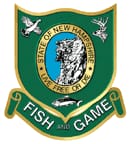Landlocked Salmon and Lake Trout Fishing Opens April 1 in New Hampshire
OutdoorHub 04.01.13

April 1 is the day New Hampshire anglers have been dreaming about through the long, cold winter — the start of open-water fishing on the big lakes that the New Hampshire Fish and Game Department (NFGD) manages for landlocked salmon and lake trout.
Mother Nature has just played a cruel joke on those anglers who recently had thoughts of vast areas of open water this spring. A winter cold snap, followed by a foot of snow has the countryside looking a lot like Christmas instead of spring! But fear not, the March sun will do its work on the snowpack and opening day will provide areas of open water for the salmon anglers.
It looks like we will experience a “normal spring” with “ice out” probably occurring mid-April. With the increased snowpack, our tributary streams will benefit with increased flows, attracting spawning smelt, the prime forage fish for landlocked salmon. Fall netting (2012) reveals strong, age-2+3 year-classes of salmon in Big Squam and Winnipesaukee lakes, which will dominate the catch. There will also be some nice age 3 salmon available in Sunapee Lake, “said N.H. Fish and Game Large Lakes Biologist Don Miller”.
New Hampshire Fish and Game manages 15 lakes for landlocked salmon: Big Dan Hole Pond, First and Second Connecticut Lakes, Conway Lake, Lake Francis, Merrymeeting Lake, Newfound Lake, Ossipee Lake, Big and Little Squam Lakes, Sunapee Lake, Lake Winnipesaukee, Winnisquam Lake, and Nubanusit Lake. Pleasant Lake in New London also is managed for landlocked salmon, but is classified as a trout pond, with a 2013 opening date of April 27.
Anglers should check out the Winnipesaukee River, which flows through the Weirs channel into Paugus Bay, and through the Lakeport Dam/Lake Opechee area. “Drop-down” salmon (and rainbow trout) are found throughout these river reaches. Other traditional areas include the Winnipesaukee River through Laconia to Dixon Point at Lake Winnisquam, and Lochmere Dam at Silver Lake. There is often a sizable piece of open water in Lake Winnisquam where the river drains into the lake. This water can be easily accessed by the NHFGD boat access ramp, just upstream in Laconia.
The Newfound River in Bristol offers great fly-fishing-only water that can often produce drop-down rainbows and salmon. Additionally, several popular Winnipesaukee shore fishing locations exist at the Merrymeeting River (fly-fishing-only, barbless, catch and release), and the mouth of the Merrymeeting River as it enters Alton Bay, downstream of the famous stone arch bridge.
Other good sites to visit include the Long Island Bridge in Moultonborough, Governors Island Bridge in Gilford, Smith River inlet at Wolfeboro Bay, and Meredith and Center Harbor town docks. At these locations, everything from smelt, shiners and worms under a slip bobber to small jigs will take salmon, as well as rainbow trout.
This time of year, salmon are successfully caught by trolling with everything from spoons (such as DB Smelt, Sutton, Mooselook, Top Gun, and Smelt Gun) to traditional streamer flies (for example, Maynard’s Marvel, Pumpkinhead, Mickey Finn, Joe’s Smelt, and the countless Grey Ghost variations), and an early season favorite, live smelt or shiners. Most early season fish are caught from the surface to about 15 feet down, with everything from planer board set-ups to the simplest of monofilament flat lines 50-150 feet behind the boat. When the wind kicks in, drifting live smelt or shiners in the waves can be highly effective. Only single hooks for bait while trolling are allowed on certain salmon/lake trout lakes, including Squam, Newfound, Sunapee, Winnipesaukee and Winnisquam lakes (See the N.H. Freshwater Fishing Digest for a complete list).
To ensure the future of high-quality landlocked salmon fisheries, anglers must take extra care when releasing salmon, as the percentage of hook-wounded fish continues to be a problem. Hook wounded/scarred fish are significantly shorter and poorer in body condition than non-hook-wounded counterparts of the same age. Using rubber nets and proper release techniques (for example, don’t “shake” fish off the hook), and releasing lightly hooked healthy salmon, while choosing to harvest previously hook-wounded fish, are ways to minimize the negative effects of hook wounding, thereby increasing the number of trophy salmon available in the future.
See a new Fish and Game video at http://www.fishnh.com/Fishing/salmon_anglers_pledge.html about landlocked salmon in NH, and tips for safe handling of these fish. Fish and Game encourages anglers to take the Landlocked Salmon Anglers’ Pledge, a cooperative, volunteer effort to help sustain quality landlocked salmon fisheries in New Hampshire’s large lakes.
N.H. fishing licenses can be purchased online at http://www.fishnh.com, or from any Fish and Game license agent. Annual resident fishing licenses are $35. Resident one-day licenses are just $10. Annual nonresident fishing licenses are $53. One-, three- and seven-day nonresident licenses are also available.
Reel in lots more information on fishing in New Hampshire, from depth maps to tackle tips — and download the 2013 N.H. Freshwater Fishing Digest or view it in searchable online format — at http://www.fishnh.com/pubs/fishing.html.

